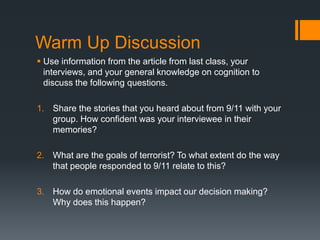
Flashbulb Memories
- 1. Warm Up Discussion Use information from the article from last class, your interviews, and your general knowledge on cognition to discuss the following questions. 1. Share the stories that you heard about from 9/11 with your group. How confident was your interviewee in their memories? 2. What are the goals of terrorist? To what extent do the way that people responded to 9/11 relate to this? 3. How do emotional events impact our decision making? Why does this happen?
- 3. Learning Outcomes Evaluate one theory of how emotion may affect one cognitive function. To what extent to which a cognitive process is reliable. We are learning about what flashbulb memories are and discussing if they are reliable. We are learning this because it allows us to better understand the nature of our memories. We should be able to use evidence from studies to evaluate the strengths and limitations of the theory.
- 4. Flashbulb Memories Highly accurate and exceptionally vivid memories of learning about a shocking or emotional event. Episodic Memories (explicit memories) that are highly resistant to forgetting because of the emotional arousal at the moment of encoding. “Flashbulb” Memory registers like a photograph Importance and arousal lead to rehearsal
- 5. Elements of a Flashbulb Memory Place (where they were when the incident happened) Ongoing Activity (what they were doing) Informant (who broke the news) Own affect (how they felt) Others’ affect (how others felt) Aftermath (importance of the event)
- 6. Tragedies…
- 7. This one is for you Bonica! And TRIUMPH!
- 8. Example…My Mom JFK Assassination: November 22, 1963 (54 years ago) Note: Video does not load online…
- 9. Brown and Kulik (1977) Study Aim: To investigate whether shocking events are recalled more vividly and accurately than other events. Method: Asked 80 (40 white and 40 black) participants to recall circumstances of learned shocking events. Findings/Conclusions: Participants had vivid memories about where they were, what they were doing, how they felt when hearing about shocking events. Whites remembered JFK better while Blacks remembered MLK. More likely for unexpected & personally relevant events. Explain: How and why does this relate to the strengths and limitations of the theory? Critical Thinking?
- 10. Limitations of Brown and Kulik (1977) -They asked people to recall…no way of testing whether those memories are correct. - Generally seen as emotionally accurate but not the details.
- 11. Neisser and Harsh (1992) Aim: To test the theory of flashbulb memory by investigating to what extent memories about the challenger explosion would be accurate after a period of time. Challenger Disaster Method: 106 students completed a questionnaire explaining details about finding out about the Challenger. (Within 24 hours of event) 2.5 years later, 44 students answered the questionnaire again. Listed 1-5 on how confident they were about their memories.
- 12. Neisser and Harsh (1992) Findings: There were major differences between the original questionnaire and the follow-up. (Avg accuracy: 2.95 of 7) Level of confidence was 4.17 Conclusion: Flashbulb Memories are not as accurate as Brown and Kulik predicted. Explain: How and why does this relate to the strengths and limitations of the theory? Critical Thinking
- 13. Evaluation + Natural environment - Importance of the event could have been different for different people.
- 14. Add Info from New Yorker Article/Have People read New Yorker… Article in bookmarks…Jane the Virgin
- 15. Hirst et al. (2015) Aim: To investigate the consistency and confidence of flashbulb memories over a long period. Method Had participants from around the nation take surveys on 9/11 within a week of the attack. Had participants take the same survey three more times. 1 year, 3 years, 10 years. Compared the results for consistency and confidence of memories. Examined how engagement with Media, Conversations, residency, personal impact, and emotional intensity impacted remembering.
- 16. Hirst et al. (2015) Findings: Consistency Confidence • Large decrease in accuracy of memory within the first year. Little change between year 1 and year 10. • The key Factors/influences had little impact on consistency of memories. • Errors in memories were more likely to be corrected after years due to impact of media sources (movies & documentaries). • Confidence remained high throughout the study. • Conversations and Media engagement led to stronger feelings of confidence.
- 17. Hirst et al. (2015) Conclusions: Even traumatic memories and those implicated in a community’s collective identity may be inconsistent over time and these inconsistencies can persist without the corrective force of external influences. Explain: How and why does this relate to the strengths and limitations of the theory? Critical Thinking?
- 18. Evaluate Flashbulb Memories Weigh the strengths and limitations of the Theory of Flashbulb Memories. What are the strengths of the theory? What does it explain well? What are the limitations of the theory? To what extent are flashbulb memories accurate?
- 19. Evaluate: Let’s Make a D.E.A.L. Use the following acronym to help you evaluate key theories. Describe the theory Evidence explanation (studies) Application (real-world applications) Limitations (of studies and theory as a whole) When discussing limitations, you can use the counterclaim/rebuttal model.
- 20. Strengths Limitations Evaluate Flashbulb Memories Explains why emotional events are more memorable. Theory has been modified to say that the event must have personal relevancy. Does not fully account for the reconstructive nature of memory. Memories often lack consistency or accuracy despite having high confidence.